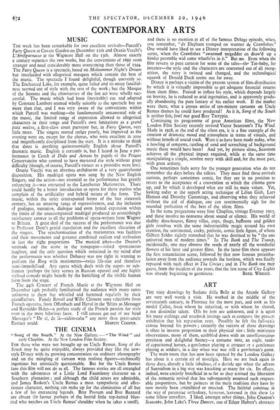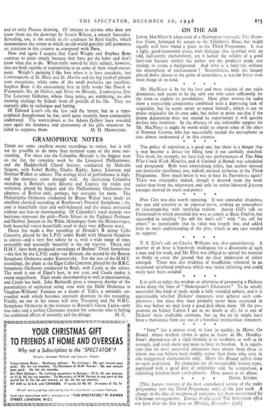ART
THE sixty drawings by Stefano della Bella at the Arcade Gallery are very well worth a visit. He worked in the middle of the seventeenth century, in Florence for the most part, and took as his model Callot, from whom he inherited, or with whom he shared, a not dissimilar talent. Oils by him are unknown, and it is upon his many etchings and notebook jottings such as compose the present exhibition that his reputation rests. Possibly he felt the full-scale canvas beyond his powers ; certainly the success of these drawings is often in inverse proportion to their physical size ; little miniature observations, many of them, scribbled down with an unselfconscious precision and delightful fluency—a costume note, an eagle, ranks of caparisoned horses, a gentleman playing at croquet ce a gentleman playing at soldiers, in a day when war was still a gentleman's game.
The main room that has now been opened by the London Gallery has about it a certain air of nostalgia. Here we are back again in those days, already a little fabulous, of a decade ago when the advent of Surrealism in a big way was knocking so many for six. Its effects, indeed, were entirely beneficial in so far as they assisted the liberation of the romantic revival that has subsequently assumed such respect- able proportions, but by painters in the main tradition they have by now mostly been assimilated or rejected. The faithful continue in the way of paranoiac orthodoxy, however, leavened in this show 1,y some fellow travellers. I liked, amongst other things, John Craxton's SeascaPe, John Lake's Three Dances, one of Edgar Hubert's abstracts
and an early Picasso drawing. Of interest to anyone who does not know them are the drawings by Scottie Wilson, a natural Surrealist. Revealing, too, is the article in the catalogue by Rene Guilly, which demonstrates the extent to which an old-world gentility still permeates art criticism in this country as compared with Paris.
Now and again I suspect that Carel Weight and Stephen Bone continue to paint simply because they have got the habit and don't know what else to do. When really moved by their subject, however, they are both capable of transmitting to us some of their visual excite- ment. Weight's painting I like best when it is least anecdotic, but Conversations of St. Mary and St. Martha and the big football picture were exceptions, while some of the small pochades are excellent. Stephen Bone is his unassuming best in little works like Punch at Weymouth, No. 96 Shelter, and Snow on Monday, Leamington Spa. The Leicester Galleries, where these artists are exhibiting, are also showing etchings by Sicken from all periods of his life. They are masterly alike in technique and feeling.
Of Edward Lear's oils the less said the better, but as a topo- graphical draughtsman he has, until quite recently, been consistently underrated. The watercolours at the Adams Gallery have revealed once again the freshness and spontaneity of his gifts whenever he



































 Previous page
Previous page